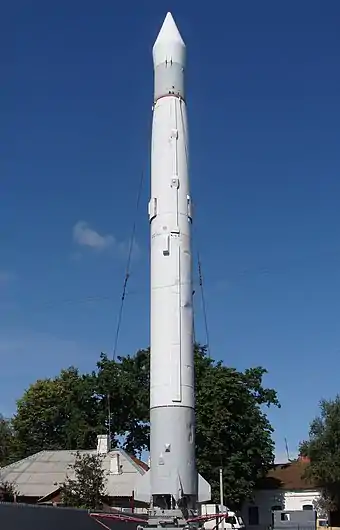R-5 Pobeda
The R-5 Pobeda[3] (Побе́да, "Victory") was a theatre ballistic missile developed by the Soviet Union during the Cold War. The R-5M version was assigned the NATO reporting name SS-3 Shyster and carried the GRAU index 8K51.
| R-5 | |
|---|---|
 R-5 on display at the Zhytomyr Korolyov Museum | |
| Type | Theatre ballistic missile Medium-range ballistic missile |
| Place of origin | USSR |
| Service history | |
| In service | 21 May 1956 – 1967 |
| Production history | |
| Manufacturer | Yuzhmash |
| Specifications | |
| Mass | 29,100 kg |
| Length | 20.75 m |
| Diameter | 1.65 m |
| Wingspan | 3.452 m |
| Warhead | 60 \ 80 kt , 300 kt , 1 Mt (or more) thermonuclear warhead |
| Engine | RD-103M, 8D52 |
| Propellant | Liquid (92% Ethanol/water solution & LOX) |
Operational range | 1,200 km (750 mi)[1][2] |
Guidance system | inertial guidance plus radio command guidance |
| Accuracy | 1.5 km[2] |
The R-5 was originally a development of OKB-1 as a single-stage missile with a detachable warhead reentry vehicle. The R-5M was a nuclear armed missile – the first nuclear missile to be deployed by the Soviet Union – with greater payload and weight but better reliability than its predecessor. The R-5M gave the Soviet Union the ability to target many strategic targets in Europe. The R-5M entered service on 21 May 1956 (retired in 1967), and in 1959 was installed at Vogelsang, Zehdenick and Fürstenberg/Havel in East Germany - the first Soviet nuclear missile bases outside the USSR.[4]
By the end of 1956, 24 launchers were deployed, with a final total of 48 produced by the end of 1957; around 200 missiles were built. The R-5M was deployed in brigades of six launchers each or regiments of four launchers each. The basic field unit was a division, each having two batteries with a single launcher. Brigades and regiments had deployments in Kapustin Yar, Kaliningrad, East Germany (from January to September 1959), Volgograd Oblast, Lithuania, the Russian Far East, and Ukraine.[5]
R-5 was additionally an oft-reported alternate designation for the K-5 (missile) air-to-air missile.
In 1958, R-5A rockets were used to launch pairs of dogs to altitudes up to 480 km.[6]
Specification
- Propellant liquid
- Range 1,200 kilometres (750 mi)
- Period of storage after fueling: 1 hour[7]
- Time of preparation 2.5 hours
- Guidance: inertial guidance plus radio command guidance
- Warhead and Yield 60 \ 80 kt, 300 kt, 1 Mt (or more) thermonuclear warhead
See also
References
- "Ballistic and cruise missile threat". Defense intelligence ballistic missile analysis committee. 2017.
- Podvig, Pavel, ed. (2004). Russian Strategic Nuclear Forces. MIT Press. p. 120. ISBN 9780262661812.
- "Soviet/Russian missile designations". Johnston's Archive.
- Stephen Evans (25 October 2012). "A Soviet missile base in Germany that spy planes never saw". BBC News.
- R-5M. Encyclopedia Astronautica.
- Harvey, Brian; Zakutnyaya, Olga (2011). Russian Space Probes: Scientific Discoveries and Future Missions. Springer-Praxis. pp. 22–23. ISBN 9781441981493.
- "Russian ballistic missiles" (in Russian). Archived from the original on 31 March 2013. Retrieved 14 September 2015.